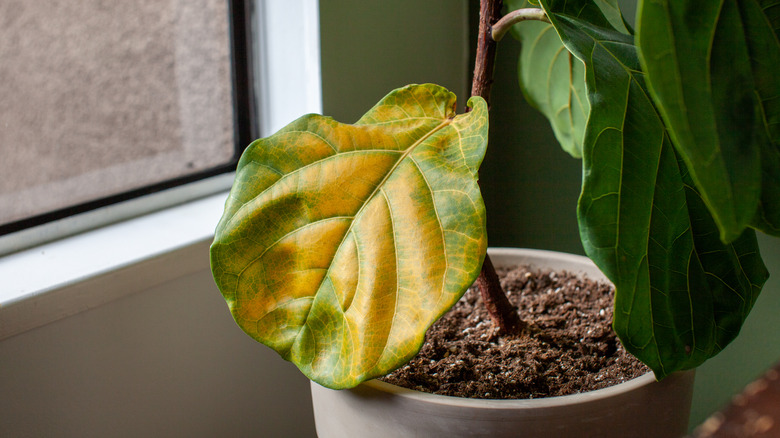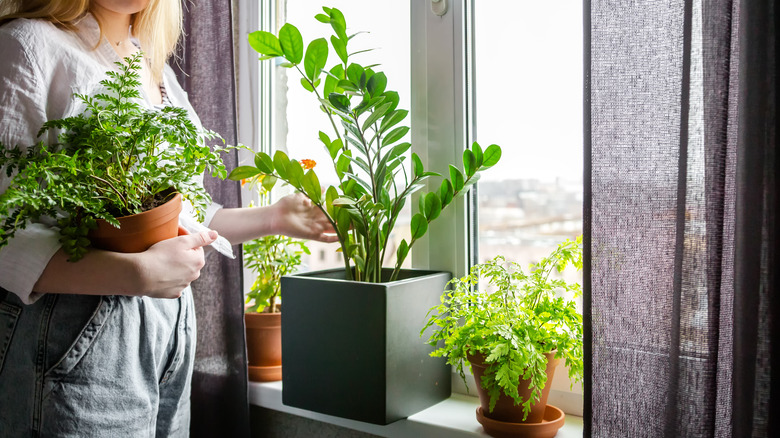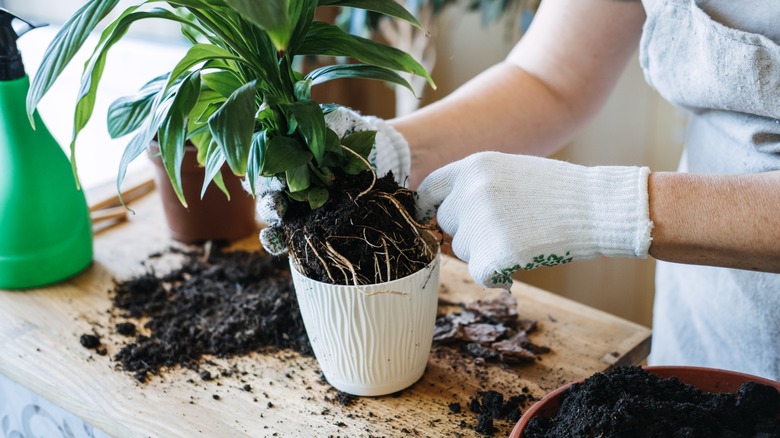You Should Change Your Indoor Plants' Soil. Here's Why
Even if your plant hasn't outgrown its pot, it's a good idea to occasionally refresh the soil it lives in. All plants leech nutrients from the soil as they grow and photosynthesize. In nature, the soil is replenished with decaying organic matter. However, in your house, potting soil doesn't get naturally replenished, which means your indoor plants will eventually run out of nutrients. The University of Maryland explains that fertilizers can remedy some micro-nutrient deficiencies in houseplants, but using too much fertilizer can lead to salt accumulation and awkward, leggy plant growth.
The best solution for keeping your plants happy, healthy, and growing strong is to follow a repotting schedule, at which time you'll change out the soil. Neglecting to repot your plants can lead to discoloration, poor growth, drooping, and even plant death. One way to see if your plant needs new soil is to feel the top inch and observe the water flow when you add water. If the soil feels stiff and tight, the water doesn't absorb, or you can see roots escaping from the drainage holes, Houseplant Resource Center says it's time to repot.
Change the soil every 1 to 2 years
Indoor Plants for Beginners explains that every plant will be different and there's no strict rule regarding when to refresh its soil. However, sticking to a schedule of repotting every 1 to 2 years is generally your best bet. Some plants, particularly succulents and cacti, will fare better with a longer time between repottings — up to 4 years. Because they're naturally found in harsh, dry conditions where they grow slowly, cacti and succulents don't tolerate frequent transplants well. Mild fertilizer is a great way to keep these plants happy between repottings. On the other end of the spectrum, durable, fast-growing plants like snake plants and pothos may benefit from more frequent repotting. These lightning-fast growers can be repotted every 6 to 12 months, but many species will continue thriving for a while in old soil.
Although indoor houseplants aren't exposed to the elements, spring is still a good time to rejuvenate the soil and repot your plants. They may not experience rain or frost, but indoor houseplants are sensitive to changes in sunlight. By giving them a boost of nutrients that will encourage them to grow with fervor, replacing the soil helps wake up houseplants for spring, explains Gulley Greenhouse & Garden Center.
How to change your houseplant's soil
Changing out the soil and repotting are stressful experiences for plants; it's crucial to do everything correctly in order to reduce transplant shock. As long as your houseplant's roots still have room to grow, you won't actually need to change the container just to refresh the soil. If you are choosing a new pot for your plant, look for a diameter 1 to 2 inches larger than your current pot at most. HuffPost warns not to go too big, as this can lead to soggy soil and root rot.
Gentle movements are the key to easily repotting a houseplant and refreshing its soil. Hold the plant at its base, flip, and gently wiggle until its roots come free. You never want to pull or yank on your plant, as this can damage the roots or sever them entirely. If you're repotting the plant, pour a thin layer of fresh potting soil into the bottom of the new pot. Place the plant and then fill around the edges with more soil. Make sure the soil is filled in completely, but don't pack it down tight. If you're reusing the same pot, carefully remove as much old, loose soil as you can from the plant's root system. Clean out the pot, then reset the plant with fresh soil. Any time you change a plant's pot or soil, finish with a good soak to help it settle in!


